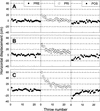Prism adaptation and aftereffect: specifying the properties of a procedural memory system
- PMID: 10355523
- PMCID: PMC311278
Prism adaptation and aftereffect: specifying the properties of a procedural memory system
Abstract
Prism adaptation, a form of procedural learning, is a phenomenon in which the motor system adapts to new visuospatial coordinates imposed by prisms that displace the visual field. Once the prisms are withdrawn, the degree and strength of the adaptation can be measured by the spatial deviation of the motor actions in the direction opposite to the visual displacement imposed by the prisms, a phenomenon known as aftereffect. This study was designed to define the variables that affect the acquisition and retention of the aftereffect. Subjects were required to throw balls to a target in front of them before, during, and after lateral displacement of the visual field with prismatic spectacles. The diopters of the prisms and the number of throws were varied among different groups of subjects. The results show that the adaptation process is dependent on the number of interactions between the visual and motor system, and not on the time spent wearing the prisms. The results also show that the magnitude of the aftereffect is highly correlated with the magnitude of the adaptation, regardless of the diopters of the prisms or the number of throws. Finally, the results suggest that persistence of the aftereffect depends on the number of throws after the adaptation is complete. On the basis of these results, we propose that the system underlying this kind of learning stores at least two different parameters, the contents (measured as the magnitude of displacement) and the persistence (measured as the number of throws to return to the baseline) of the learned information.
Figures




References
-
- Bossom J. The effect of brain lesions on prism-adaptation in monkey. Psychon Sci. 1965;2:45–46.
-
- Cohen HB. Some critical factors in prism-adaptation. Am J Psychol. 1966;79:285–290. - PubMed
-
- Foley JE, Maynes FJ. Comparison of training methods in the production of prism adaptation. J Exp Psychol. 1969;81:151–155. - PubMed
-
- Ghez C. The control of movement. In: Kandel ER, Schwartz JH, Jessell TM, editors. Principles of neural science. Norwalk, CT: Appleton & Lange; 1991. pp. 533–547.
-
- Hardt ME, Held R, Steinbach MJ. Adaptation to displaced vision: A change in the central control of sensorimotor coordination. J Exp Psychol. 1971;89:229–239. - PubMed
Publication types
MeSH terms
LinkOut - more resources
Full Text Sources
Medical
